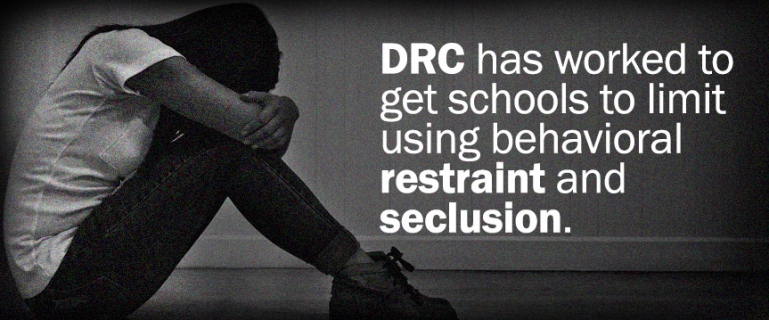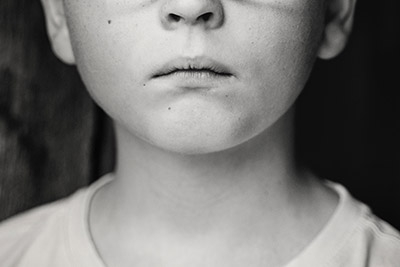DRC successfully limits the use of restraint and seclusion in schools

DRC successfully limits the use of restraint and seclusion in schools

Governor Brown signs DRC legislation limiting schools’ use of restraint and creating protections against the abuse of this practice.
Behavioral aides and two classroom teachers held Juan, an 11-year-old Latino who has autism, on the floor of his classroom when he became agitated after refusing to comply with his teacher’s repeated request to pick up a piece of paper from the floor. Juan later explained that the piece of paper was not his. Medical records show that Juan got a closed head injury, a concussion and facial injuries (possibly a broken nose) from the restraint event. Staff admitting to holding Juan on the hard floor but could not explain how he got hurt. In another school in a different part of the state, 10-year-old Marcia, who also has autism, was restrained by classroom aides 45 times in a single month. A subsequent state investigation uncovered over 500 restraints in Marcia’s special education program, including two students who were restrained over 100 times each.
Unfortunately, these incidents happen far too often to students with disabilities who are having behavioral issues and students of color, especially African American boys.
For over a decade, DRC has worked to limit the use of behavioral restraint and seclusion in schools. Our work has include conducting dozens of investigations into abusive restraint and seclusion practices, publishing two reports highlighting the unregulated use of these dangerous practices, and four legislative initiatives to codify protections. This week, our legislative efforts succeed with the Governor’s signature of Assembly Bill 2657
While it is appropriate to intervene in an emergency to prevent a student from imminent risk of serious physical self-harm or harm of others, restraint and seclusion are dangerous interventions with certain known practices posing a great risk to child health and safety. Restraint and seclusion are safety measures of last resort and should never be used as punishment or discipline or for staff convenience. Restraint and seclusion do not keep children safe and they may cause serious injury, long lasting trauma and death, even when done safely and correctly. There is no evidence to restraint or seclusion are effective in reducing the problem behaviors that frequently precipitate the use of such techniques.
Disability Rights California Public Reports:
Restraint & Seclusion in California Schools: a Failing Grade (2007)
 For many years, DRC (then Protection and Advocacy, Inc. or PAI) heard anecdotal reports of excessive and inappropriate restraint and seclusion practices in schools but had not received any specific complaints. In the spring and summer of 2006, we received eight complaints of abusive restraint and seclusion of elementary, middle and high school students in California schools and promptly initiated in depth investigations into each. A 10-year old boy with significant disabilities was tied (e.g. restrained) to his wheelchair and left in the school van on two separate days. Another school built a locked seclusion room where an 8-year old boy with psychiatric and developmental disabilities was routinely id behind a locked door with inadequate staff supervision. Other children were dragged by their teachers into seclusion areas and then barricaded from leaving.
For many years, DRC (then Protection and Advocacy, Inc. or PAI) heard anecdotal reports of excessive and inappropriate restraint and seclusion practices in schools but had not received any specific complaints. In the spring and summer of 2006, we received eight complaints of abusive restraint and seclusion of elementary, middle and high school students in California schools and promptly initiated in depth investigations into each. A 10-year old boy with significant disabilities was tied (e.g. restrained) to his wheelchair and left in the school van on two separate days. Another school built a locked seclusion room where an 8-year old boy with psychiatric and developmental disabilities was routinely id behind a locked door with inadequate staff supervision. Other children were dragged by their teachers into seclusion areas and then barricaded from leaving.
Our 2007 report was the first report published nationally that drew attention to the abusive and unregulated use of restraint and seclusion in schools. We called for improvements to bring the practices of schools-based behavioral restraint and seclusion in line with those applied in other settings.
Restraint and Seclusion in Schools: Recommendations for California (2015)
After the California repealed long-standing regulations pertaining to emergency behavorial interventions in schools, in 2015, DRC issued a second report, again calling for California to enact legislation setting minimum protections for the use of restraint and seclusion in schools. The report described increasing national attention on the issue and actions taken by a number of states, at the urging of the Secretary of the United States Department of Education, which set new standards. In comparison, California not only failed to implement laws addressing restraint and seclusion in schools but took a step backwards, repealing requirements that schools take proactive steps to address challenging behaviors of students with disabilities and report on the number of emergency behavioral interventions (e.g. restraint or seclusion) that occurred.
The report again called for the legislature to establish minimum protections regarding the use of restraint and seclusion in schools and urged schools to collect and publish data regarding the use of these interventions.
DRC’s Legislative Efforts
DRC sponsored four legislative efforts to limit the use of restraint and seclusion in schools. Following release of the 2007 report, DRC worked with Senator Kuehl to bring Senate Bill 1515, which was vetoed by then Governor Schwarzenegger. Two other legislative efforts, Assembly Bill 1538 (Ma, 2009) and Assembly Bill 519 (Hernandez, 2011) did not make it out of the legislature.
In 2018, DRC sponsored Assembly Bill 2657 (Weber). This bill set limitations on the use of restraint and seclusion similar to those in other settings where these practices are used. It grants students the right to be free from the use of seclusion and behavioral restraints of any form imposed as a means of coercion, discipline, convenience, or retaliation by staff. Education staff are prohibited from using particularly dangerous restraint practices and must closely monitor students when in restraint or seclusion. Education providers are required to collect and report data regarding their restraint and seclusion use.
On August 29, 2018, AB 2657 was sent to the Governor for signature. On Sunday, September 30, 2018, Governor Brown signed the bill. Bonnie Candell, the mother of a child who was restrained over 90 times in 11 months, “I am very proud of [my son] for using his experience for change. And I’m grateful for DRC and to everyone who has worked hard on this issue so that our children our safe.”
DRC’s Publicity Campaign
DRC has published a number of informational videos about the risks and trauma with restraint and seclusion in schools and alternative practices. Here are a few examples found on DRC’s YouTube channel DisabilityRightsCA:
- Restraint and seclusion are abusive practices.
- Restraint and seclusion don’t belong in school
- Stuart describes the harm of being restrained in school.
- Restraint and seclusion do more harm than good
- Restraint and Seclusion - Keith & Zander
- Keeping students safe: Reducing restraint and seclusion in California Schools – Xander’s story
- Restraint and Seclusion Alternatives




